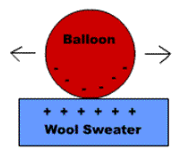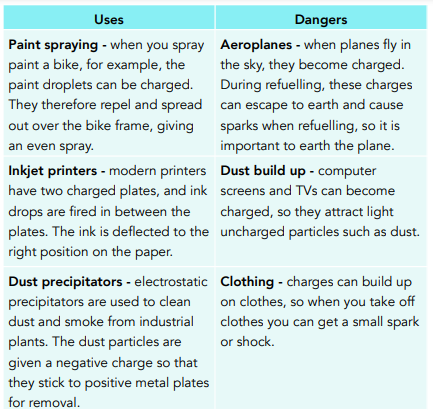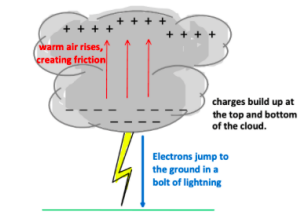Static Electricity (GCSE Physics)
Static Electricity
Static Electricity
- Rubbing surfaces leads to static electricity. When we rub two surfaces together, we produce static electricity. This occurs when electrons move from one surface to the other. We get a build up of static positive charge on one surface, and an equal static negative charge on the other surface.
- A charge difference is created. As charge builds up on a surface, we start to create a difference in charge between the charged surface and the earth. Usually, the earth is at zero volts. As we charge the surface, the difference in charge between the surface and the earth will get bigger and bigger.
- Static electricity leads to sparking. Eventually, the charge difference between the earth and charged surface gets so big that electrons will jump from the charged surface to the earth. As the electrons jump, we will be able to see a spark.
An Example of Static Electricity
Question: Laura takes an uncharged balloon and a jumper. She rubs the balloon against the jumper for several seconds. Laura then touches the jumper and experiences a small electrical shock. Why has this happened?

- When the balloon is rubbed against the jumper, we get electron transfer. As the balloon rubs against the jumper, electrons will be transferred from the balloon to the jumper. This results in a negatively charged jumper and a positively charged balloon.
- When Laura touches the jumper, the electrons are transferred to her. Compared to the jumper, Laura is positively charged. Therefore the electrons jump across the gap between the jumper and Laura’s hand, creating a spark (and therefore an electrical shock).
- The electrons are trying to get to the earth. Electrons are always trying to get to the earth. This means that they will go through Laura’s body and travel straight down into the earth. In this situation, we would refer to Laura as an ‘earthed’ object; she is in contact with the earth, therefore providing a pathway for the electrons.
General Uses and Dangers of Static Electricity
Uses and Dangers


Lightning
- Warmer air is less dense than colder air. Warm air in clouds rises, as it is less dense than colder air. The warmer air carries small ice crystals as it moves upwards.
- An electric charge is created. As these crystals move upwards, they rub together causing an electric charge to form at the top and bottom of the cloud.
- Lightning is caused by this electric charge. Eventually the charge becomes so large that electrons jump to the ground, which we see us a bolt of lightning.

Question:
- The only way electrostatic charges can be produced is by the movement of electrons.
- Static electricity causes hairs to attract each other and therefore stand up on end
- If you rub a plastic rod with a cloth, the rod becomes positively charged, and cloth negatively charged.
- You can charge two insulators by using friction.
Which of the above statements are true?
- True – this is true, electrons can move but protons cannot.
- False – this is incorrect, as electrons are transferred from the object rubbed to the hair, causing an accumulation of charge. As the hair strands are all the same charge, negatively charged, the hair strands repel each other and stands on end.
- True – During rubbing, electrons move from the rod to the cloth. Protons never move. The rod becomes positively charged as it loses electrons. The cloth becomes negatively charged as it gains electrons.
- True – Friction can cause the movement of electrons, so this is true.
Static electricity is a type of electricity that is created by the buildup of electric charges on the surface of a material. This buildup occurs when two materials are rubbed together, causing electrons to transfer from one material to the other, creating an excess of electrons on one material and a shortage of electrons on the other.
Static electricity works by the transfer of electrons from one material to another. When two materials are rubbed together, electrons can transfer from one material to the other, creating an electric charge. The resulting buildup of electrons on one material creates a negatively charged material, while the shortage of electrons on the other material creates a positively charged material.
Static electricity has many real-life applications, including in electrostatic spray painting, electrostatic precipitation, and electrostatic induction. It is also used in the production of computer chips, as well as in electrostatic discharge (ESD) protection for sensitive electronic equipment.
While static electricity can be useful in some applications, it can also pose a danger in certain situations. For example, static electricity can cause sparks that can ignite flammable materials or cause explosions. It can also cause damage to sensitive electronic equipment, such as computers and other electronic devices.
Static electricity can be prevented by using materials that are conductive or by using humidifiers to increase the humidity in the air. Another method is to ground the materials that are producing the static electricity, which allows the excess electrons to flow away from the material and prevent the buildup of static charges.
Some interesting experiments that can demonstrate static electricity include rubbing a balloon on your hair and sticking it to a wall, using a Van de Graaff generator to generate high voltage static electricity, and creating sparks by bringing two materials with different electric charges close to each other.
These questions and answers provide a comprehensive overview of static electricity, making it easier for 15-16 year old students to understand the concept as they prepare for their GCSE physics exams.





Still got a question? Leave a comment
Leave a comment